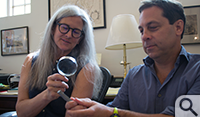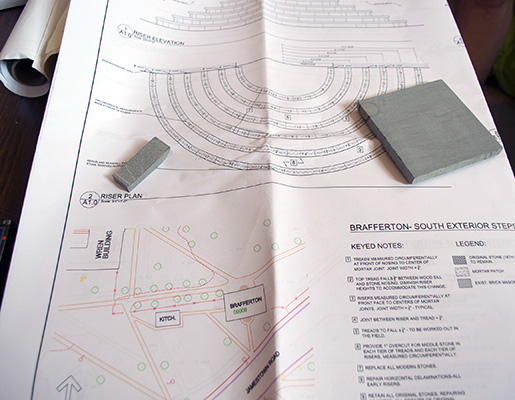Eye of the beholder
We want to buy several tons of this ugly stone. Why? History.
Chuck Bailey says it is some of the ugliest stone he’s ever seen.
Bailey has looked at a lot of stone. He’s professor and chair of William & Mary’s Department of Geology.
But what Bailey found in his mailbox one day in the summer of 2016 was so drab, so geologically lackluster, that he thought for a minute he was holding a chunk of concrete in his hand. First impressions can be deceiving, though, as Bailey found out that he was holding a sample with an illustrious pedigree, a stone that would spark a transatlantic search for its origin.
Susan Kern was the person who put the samples in Bailey’s mailbox. Kern, the director of William & Mary’s Historic Campus, has been working with restoration stonemason Ray Cannetti on a long-term project to replace the exterior steps of the Brafferton.
 The Brafferton is the second-oldest building on the campus of America’s second-oldest university. It was constructed in 1723, using funds from the estate of the Anglo-Irish scientist Robert Boyle. Its original purpose was to house William & Mary’s Indian School. The Brafferton now contains the offices of the university’s president and provost and its early history is a subject of an exhibit at the Muscarelle Museum.
The Brafferton is the second-oldest building on the campus of America’s second-oldest university. It was constructed in 1723, using funds from the estate of the Anglo-Irish scientist Robert Boyle. Its original purpose was to house William & Mary’s Indian School. The Brafferton now contains the offices of the university’s president and provost and its early history is a subject of an exhibit at the Muscarelle Museum.
The steps need attention
The building underwent extensive restoration work in 2011-12, work that was preceded by archaeological investigation, a collaboration between William & Mary’s Department of Anthropology and the Colonial Williamsburg Foundation. But now the Brafferton’s steps need attention, particularly those on the south side, facing Jamestown Road.
“The steps were holding moisture. They were constantly wet,” Kern said. “And so we tried to figure out why. The thought was that the steps were sinking toward the building. In fact, we discovered that they’d been repointed with a cement mortar that was trapping moisture, and the front was rising, rather than the back sinking.”
She added that the steps are perfectly sound and safe to walk on now, but their condition prompted Kern to set into motion a project that would see both sets of Brafferton steps completely reconstructed. And if at all possible, Kern said she would like to use sandstone from the original quarry that supplied the early 18th century steps. She enlisted Bailey’s assistance in tracing the stone.
Sourcing the stone requires a history-geology detection collaboration. Both Bailey and Kern believe that the original stones were quarried and dressed in England, then shipped here to Virginia to be assembled on site.
No quarries on the Coastal Plain
“These blocks of sandstone were quarried in the early 18th century. That didn’t happen around here,” Bailey said. “The Coastal Plain is rich in sand and mud, but not lithified stone that we can quarry. And at that point in time, we hadn’t expanded far enough west into the Appalachians for people to be quarrying stone in any significant way.”
Kern said that most of the stone in the Brafferton steps today is Pennsylvania bluestone, dating to the 1932 Rockefeller restoration of Williamsburg. Kern said the Rockefeller restoration had to use the Pennsylvania bluestone throughout Williamsburg, because the American sandstone quarries had been idled by the Depression.
The two lower courses on the south side steps date to the 18th century and provided the samples that Bailey used for the microscopic analysis that was the start of a history-geology detection collaboration. He presented what the microscope reveals about the Brafferton steps at a meeting in Kern’s office in the Wren Building.
“Mineralogically, it’s got a lot of stuff in it,” Bailey explained. “If you were to put a name to this, I would call it a fine-grained arkosic sandstone.”
The “stuff” in the Brafferton sandstone is mostly quartz, he said, but more interestingly, the stone contains a considerable portion of feldspar — a mineral that’s much more common in igneous rocks than in sedimentary stone such as sandstone. Bailey’s analysis revealed other content, chiefly muscovite and iron oxide.
“The rock is very well sorted, that is, all the bits are about the same size. It is glued together by a bit of a silica and iron cement,” Bailey continued. He went on to say that a geologist might call it “dirty sandstone,” or more formally, “first cycle” sandstone, rock that hasn’t had its mineral content removed by weathering and erosion.
Information written in stone
“One of the great things about sandstone is that what’s in it gives you a lot of information about ancient environments,” he said. “The fact that this is mineralogically heterogeneous suggests to me that the source area was a heterogeneous terrain, probably something underlain by granite, because we have a lot of feldspar and mica.”
Bailey pointed to geological maps of southern Britain, explaining that the Brafferton sandstone seems wrong for the southeast corner of Britain, home of the famous White Cliffs of Dover, which he noted are a kind of limestone.
“In this region of England, the sandstone is almost all second- or third-cycle sandstone. It’s cleaner than our sandstone,” he said. Bailey showed another map, this one depicting another corner of England that offered a more fitting geological profile for the Brafferton stone.
“My hunch — and it’s only a hunch right now — is that it came from the west or the southwest of England,” he said.
Kern points out that the English quarries of centuries past were almost all small affairs and often did business by renting out the quarry to builders as needed. There is still plenty of English stone being quarried; Kern showed some samples of sandstone on offer by English quarries, included one marketed as “Dunhouse Blue.” But there’s only a slim chance that the very same 18th century quarry that produced the original Brafferton steps remains in business.
“It could be under a car park,” Kern said. “Like Richard III.”
Working with Cannetti, whom she called “the best restoration mason in the business,” Kern has prepared a set of drawings for the step restoration, a project that should be completed in about two years.
She said if they can’t find the original quarry, Dunhouse Blue, quarried in Lancaster, and other options are close enough to provide a satisfactory substitute. Bailey said that a geologist would describe Dunhouse Blue as a Paleozoic sedimentary rock. He also said the Dunhouse Blue samples offer a distinct advantage: They’re much more attractive than the original Brafferton stone.
“To me, it’s a very bland-looking rock,” he said. “I’m not giving it high marks for appearance, and I’m sorry the provost has to walk over them twice a day.” ![]()
















